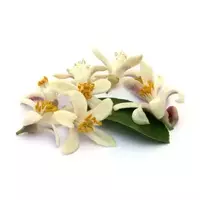Citrus flowers

The concept of edible flowers appeared quite a long time ago, but their use for culinary purposes began even earlier - more than a thousand years ago. In those days, various dessert dishes, salads and drinks decorated with inflorescences of various. Moreover, recently, interest in the cultivation of edible plants, including their flowers, has increased extremely. So, even specialized farms began to appear that grow edible flowers on an industrial scale.
As a rule, among the most common types of flowers that are eaten, chrysanthemum, nasturtium, rose, sakura, cloves, lavender and many others can be distinguished. For example, the leaves of young nasturtium, chrysanthemum flowers or marigold petals in the culinary business of many countries have long been considered classics. Daisies, violets, thyme, rosemary, sage, as well as inflorescences and young dandelion leaves are also used in gastronomy.
Among all this variety of color palettes and flavors, citrus flowers are also popular. They are used similarly to inflorescences of other types of edible plants and herbs - citrus flowers are usually decorated with some exquisite dishes, salads, cakes, sandwiches. In addition, citrus flowers are often frozen in ice cubes, and then used to decorate drinks.
Meanwhile, citrus (Citrinae) are subtribes of flowering woody plants that belong to the Rutaceae family. They are also included in the tribe Citreae, which implies the subfamily Pomerantsev (Aurantioideae).
The most famous representatives of this group is the genus Citrus. So, some of its species (in particular, orange, lemon, grapefruit and mandarin) are widely cultivated by fruit trees on an industrial scale, while their fruits, which are an important export commodity, are highly valued for excellent food qualities.
Citrus flowers (for example, lemon and orange) also act as valuable raw materials for culinary art, and also serve as an excellent addition to various kinds of drinks, desserts and salads. Fragrant citrus flowers are often added when making jam. And on their basis, special citrus water is produced.
Some types of citrus fruits can bloom and bear fruit even in indoor conditions, so many lovers of exotic plants are happy to grow them at home. By the way, the fruits, leaves and flowers of citrus fruits in their composition contain a lot of essential oils, which are responsible for their pleasant aroma.
In addition, special substances - phytoncides - can be released into citrus leaves and flowers, which suppress disease-causing bacteria, thereby having a disinfecting effect.
citrus flowers 0 kCal
Energy value of citrus flowers (Ratio of proteins, fats, carbohydrates - ju):
Proteins: 0 g (~ 0 kCal)
Fats: 0 g (~ 0 kCal)
Carbohydrates: 0 g (~ 0 kCal)
 Español
Español Français
Français Português
Português Русский
Русский 简体中文
简体中文 繁體中文
繁體中文 日本語
日本語 한국어
한국어 العربية
العربية Türkçe
Türkçe Қазақ
Қазақ Deutsch
Deutsch Italiano
Italiano Українська
Українська
